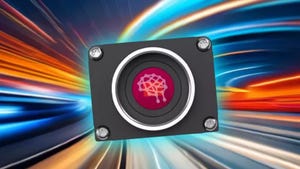February 4, 2002

The boom in communications, as in cellular phones, and beginnings of the mobile computing revolution, such as PDAs, are fueling the growth in the microprocessor and DSP (digital signal processor) market. That assessment, even in current recessionary times, comes from Micro Design Resources (San Jose, CA) Principal Analyst and Editor-in-Chief Max Baron. And he notes, waiting in the wings to further fire up this growth are wireless applications in both communications and computing, whereas "PCs and servers are suffering due to the drop in e-commerce that began late in 2000."
In the embedded world, Baron sees two "powerful applications" for microprocessors starting to take off. First are digital cameras, now coming into volume use with the advent of low-cost (approx. $70) models onto the market. Second is mobile music, as with MP3 players, which are not limited to flash-memory solid-state devices but those with compact disk-like technology as well as the latest developments in high-density hard drives.
|
|
While such portable applications may be keying microelectronics' growth, ever increasing processing density is also taking computational power to where it couldn't go before-and where it makes a difference in performance. In fact, a recent survey of design engineers finds two-thirds looking at steady or increased incorporation of embedded systems and microprocessors into their companies' products (see chart). Smaller microcontrollers and integrated packages allow their placement in places they couldn't fit before. And many of these environments are not merely benign office conditions but the harsh reality of an automotive engine compartment or even inside the human body, places where ruggedness and safety are absolutes in design.
Here's a trio of microprocessor applications that wouldn't have been possible until recently:
Chip boosts turbocharger utility
Application:
Variable Geometry Turbocharger, developed by Hella KG Hueck & Co (Lippstadt, Germany, www.hella.com) for Garrett (Torrance, CA) and controlled by the STMicroelectronics "mechatronic" system-on-chip L9805. An external magnetic sensor provides position feedback.
Microcontroller functions:
The microcontroller inside the L9805 runs a control algorithm that determines the optimal position of the turbocharger waste gate. It allows intake boost pressure and fuel efficiency to be maximized, while exhaust gas emissions are minimized.
Alternatives:
An implementation without the L9805 would have required a microcontroller, a voltage regulator with protection features, an interface IC, an H-bridge IC, and possibly additional components-all taxing available space.
Engineering challenges:
Tight space requirements demanded a single-chip implementation. Precise thermal monitoring and management were essential for placing electronic components in such a hot environment. The L9805 enables use of a sophisticated thermal management algorithm that provides the necessary protection.
Microcontroller details:
Name: L9805, STMicroelectronics (Phoenix, AZ, http://us.st.com)
Number of I/O: 10 multifunction bi-directional I/O lines
Price: $5.00 to $5.80 in volumes less than 250,000 (typical). Varies with customization, package type, and purchase volume.
Size (l/w/h): 17.5x17.5x2.75 mm
Power consumption (active/standby): Power consumption is mainly in the motor-driver outputs, not the microcontroller, and depends primarily on the motor's external loading. By comparison, power consumption in the micro-
controller is insignificant, and standby power consumption is essentially nil.
Current (run/wait/halt): 100 mA/10 mA/200 muA
Operating voltage: 6.4 to 18V, with tolerance of pulses as high as 40V
Clock rate/source: 8-MHz internal frequency from 16-MHz crystal/ceramic resonator
Memory: 16 kbytes program, 256 bytes data RAM, 128 bytes EEPROM
For more information on the L9805 mechatronic chip from STMicroelectronics: Enter 545
Microcontroller takes a licking
Application: Flashing, tongue-piercing Strobe Studz from Steel Skin (Poway, CA, www.steelskin.com) which uses a Microchip Technology PIC-12C509A PICmicro(R) microcontroller. The chip, a watch battery, and a pair of LEDs are mounted within a sealed, implant-grade stainless-steel, 0.4-inch diameter stud tip that screws onto a piercing jewelry stem.
The bio-compatible acrylic and an O-ring keep out moisture. As with a pocket flashlight, the LEDs come on when the ball is screwed down fully into the stem-lighting up the wearers mouth.
Microcontroller functions:
Generate random-sequence flashing of an LED for "rave" goers.
Alternatives:
None. Any alternative would be too large for comfort or safety.
Engineering challenges: Integration of other electronics. Engineers eliminated battery shorting with an insulation coating on the inside of the bottom half of the stud housing. They turned to clear dental acrylic for encapsulating the LEDs instead of Lucite(R) because the acrylic's refraction characteristics dimmed the light less.
The device also incorporates power-on reset and features in-circuit serial programming with programmable code protection.
Microcontroller details:
Name: PIC12C509A, Microchip Technology (Phoenix, AZ, www.microchip.com)
Number of I/O: 8 pins, 6 used. 25 mA source/sink per I/O
Price: $0.95
Size (l/w/h): SOIC package, 5.334/8.103/2.0 mm maximum
Power consumption: 3Vx0.55 mA =1.65 mW (estimate based on device characterization), stud flashes for 20 hours
Current: 0.55 mA
Operating voltage: 3V
Clock rate/source: 4-MHz internal RC oscillator, 8-bit TMR0 and Watchdog timers
Memory: 1,024 bytes program, 41 byte RAM
For more information on PIC-12C509A microcontroller by Micro-chip Technology: Enter 546
Microprocessor coordinates fridge message center
Application:
Messenger center in Amana refrigerator freezer (Amana, IA, www.amana.com) run by a Toshiba microprocessor chip. The center serves as a family message repository and controls some appliance functions.
Microcontroller functions:
The chip controls the message center display (in three languages), tracking of voice messages on a separate storage chip, water-and-ice dispensing combinations, nightlight, monitoring of water-filter usage, and timekeeping functions. The latter include determining and displaying the time and duration of any power failure to alert users to possible food spoilage.
Alternatives:
Larger electronics components would have generated more heat and would have been difficult to fit within the space envelope available.
Engineering challenges:
Engineers had to fit the entire system into a 9- x 2.5-inch envelope with a sloping depth from 0.41 to 0.85 inch; find a micro-controller that met standard Amana tests, including ESD (electrostatic discharge), grounded and ungrounded conditions, lightening surge, and fast electrical transients plus environmental tests, all while functioning under spec temperature range of 5 to 60C. The LCD would sometimes go into a non-responsive state. Solution was to have the controller periodically write to a non-visible area on the LCD and read it back to ensure accuracy. If not (the unwanted state), then the controller automatically resets the LCD module.
Microcontroller details:
Name: TMP95CW64, Toshiba America Electronic Components (San Jose, CA, www.toshiba.com/taec
Number of I/O: 100 pins, 81 usable I/O ports
Price: $6.70
Size: (l/w/h): 0.5x0.5x0.0625 inch
Power consumption (active/standby): 250/200 mW
Current (active/standby): 50/40 mA
Operating voltage: 5V
Clock rate: 8 MHz (derated from 20 MHz to save power)
Memory: 128 k ROM, 4 kbytes RAM
For more information on TMP-95CW64 microprocessor by Toshiba America Electronic Components: Enter 547
DSP forms 3D display
Application: Helios 3-D volumetric display, developed by Actuality Systems (Reading, MA, www.actuality-systems.com) and controlled by the TMS320C6201 DSP (digital signal processor) from Texas Instruments. The display, which looks like a 20-inch crystal ball, shows three-dimensional images that seem to float in the air. Viewers can walk around the display and see the image from all sides. Applications for the display include molecular modeling, medical imaging, military and aerospace, and mechanical design.
|
|
Microcontroller functions: In addition to general control functions, the TMS320C6201 performs transformations from geometry descriptions to "voxels" (volumetric pixels) in the Helios' unique coordinate system.
Alternatives: The computations could not have been performed without the DSP except possibly by connecting a host computer to the 3-D display, in which case system performance would have suffered.
Engineering challenges: Main challenge was computing the geometry-
coordinate transformations. These were proved feasible by using a Texas Instruments' DSP evaluation board as a reference design. Another challenge was the need to move data very quickly in and out of 6 Gbits of DDR (double-data-rate) SDRAM (synchronous DRAM) memory. The engineers accomplished this by implementing a DMA (direct memory access) controller in a Xilinx FPGA (field programmable gate array).
Microcontroller details
Name: TMS320C6201 DSP, Texas Instruments Inc. (Dallas, TX, www.ti.com)
Number of I/0: Two high-speed multi-channel buffered serial ports
Price: $82.75 (typical)
Size (l/w/h): Approx. 33 x 35 x 3.5 mm
Power consumption (active/standby): 1.7/0.8W
Current (operating/standby): 710/335 mA
Operating voltages: 1.8V for processor core, 3.3V for I/O
Clock rate/source: 200 MHz from external source; additional clocks from on-chip PLL (phase-locked loop)
Memory: 64 kbytes program, 64 kbytes data
About the Author(s)
You May Also Like







